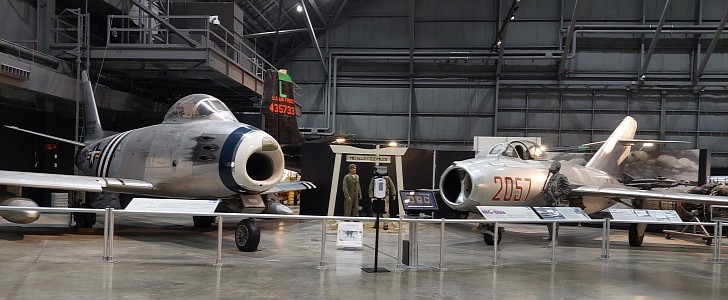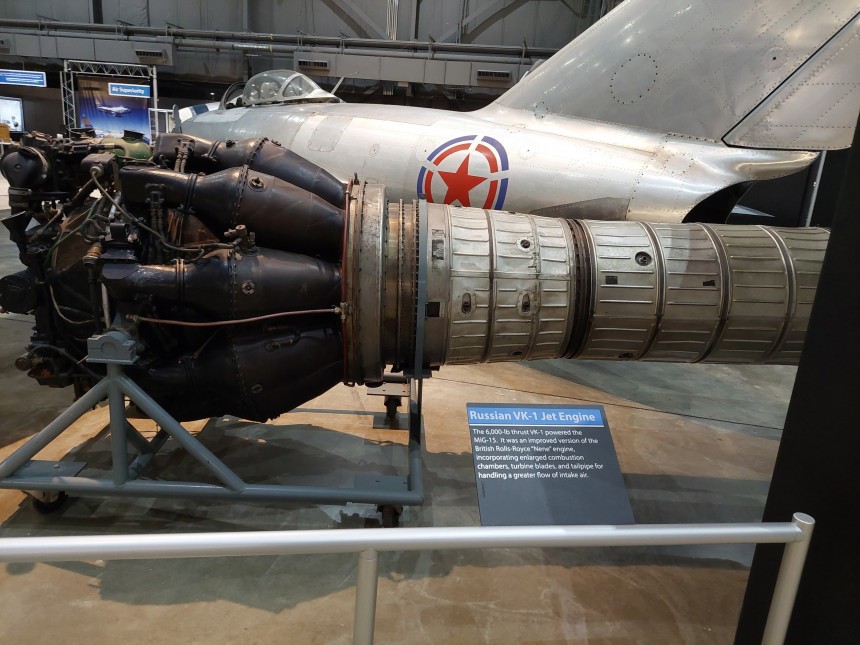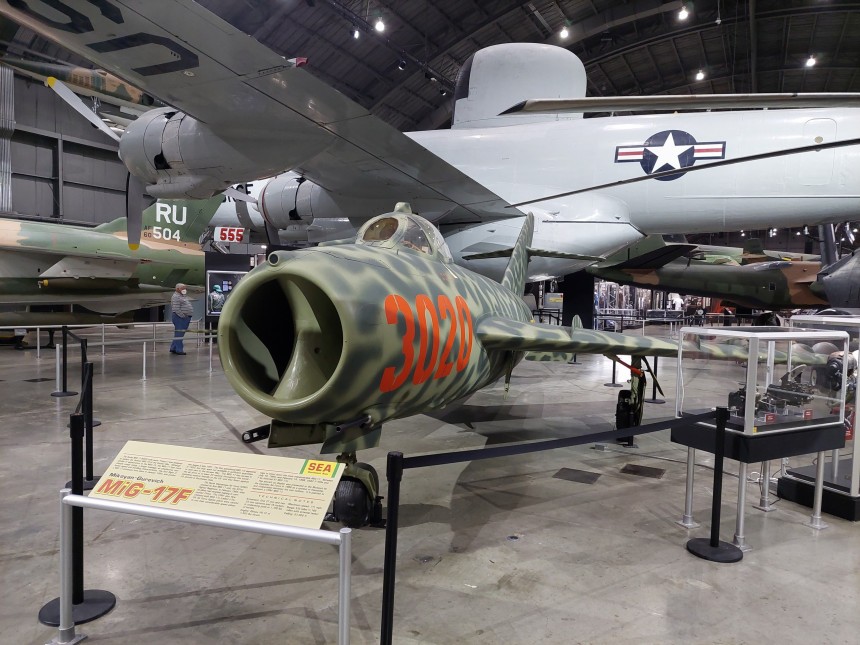In the immediate aftermath of World War II, the newly founded U.S. Air Force was essentially untouchable, or so they thought. As one war turned into another and that notion was tested over the skies of Korea, it turned out that American air superiority over the skies of a hostile force was greatly exaggerated.
Thanks in no small part to a design Soviet design team called Mikoyan-Gurevich, or "Mikoyan," or just "MiG," for short, and an especially charitable donation they received from the post-war British government, of all people.
Like so many of the great allied aviation companies that dominated post-war airspace, Mikoyan-Gurevich honed their skills in aircraft construction over the ravaged skies of Europe during the Second World War. The war served as a proving ground for the fledgling design bureau, who'd only been formed a few months after the German invasion of Poland.
Between the piston-engined MiG-1 and the upgraded MiG-3, over 3,500 models produced formed one of the many walls of defense the Soviet Union used against advancing Axis powers in battles like Stalingrad and Kursk, backing up great swarms of Soviet T-34 tanks that fought in the largest tank battle in history. At war's end, it was apparent that jet engine technology was the way forward for air superiority. It was a field the Russians were slow to adapt to initially until the Russians received an unexpected but no less welcome helping hand from the British.
The Rolls Royce Nene turbojet was a technological marvel of its time. The type of kit that even the Americans were jealous of in its day, as they asked permission to copy the design for their Pratt & Whitney J48 engine. You'd assume that the government leaders who funded such a design would do anything they could to keep it classified. But then again, you haven't met The Right Honourable Clement Richard Attlee, Winston Churchill's replacement following Allied victory in Europe.
In a "goodwill" gesture that made the U.S. military facepalm every fiber of its being, parliamentary leaders offered the fellow victorious Russians the blueprints for the Nene's design. Soon after, crates filled with jet engines arrived on Russian soil. In a move that surprised absolutely nobody in hindsight, the Soviets would go on to use the reverse-engineered engine to try and kill enemy British pilots only a few years later. Smooth move, right?
The aircraft that would do the dirty deed is one nearly all military vehicle fans are intimately familiar with. The MiG-15, whose NATO callsign is so unfortunate from a modern perspective that we'll just let you google it, was poised and ready to fight by the time hostilities boiled over in the skies over the 28th parallel. Of course, before the swept-winged MiG-15 was the straight-winged MiG-9, but this pre-Korean War jet was not based on the Nene platform and was so slow and pig-like that Communist forces opted to leave it out of the Korean conflict.
In the initial stages of the war, the skies above Korea were a slaughterhouse. Allied pilots in their Gloster Meteors, Lockheed Shooting Stars, and Republic Thunderjets did their best to fend off the menace that was the MiG-15. But these early jets were objectively out-classed in nearly every possible metric. The fear of losing air superiority mortified the American lead forces during the war. So much so that the prototype North American YP-86, soon to be renamed the F-86 Sabre, was fast-tracked into service before flight testing was finished.
The MiG-15 and the F-86 would become one of the most iconic pairings of enemy fighters ever to see combat, on par with the Spitfire vs. the Messerschmitt 109, or the Grumman Hellcat vs. the Japanese Zero. An armistice would bring an end to this war, and from the design of the second generation of MiG-15 fighters, known by the "bis" designation, came the faster and more advanced MiG-17, Nato callsign Fresco.
The MiG-17 was bigger, had longer and more aerodynamic wings, and was slightly wider than its predecessor. But still, the MiG-17 used an engine based on the same Rolls-Royce engine that powered the MiG-15. In the faster MiG-17, this engine could propel the aircraft to the ragged edge of the sound barrier or Mach one. Like its forbearer, the MiG-17 would go on to become a complete nightmare for American pilots over the skies of their next major war in Southeast Asia in their F-4 Phantom IIs, F-100 Super Sabers, and F-105 Thunderchiefs.
In a move that surprised nobody, Britain would never again be this charitable to the Soviet military. The U.K would stand alongside the Americans as bitter enemies of Communism for the rest of the Cold War, their potential air dominance of early post-war battlefields totally up in smoke. If you ever wondered why the U.S. military was so hesitant to let any other nation touch the F-22 Raptor stealth fighter today, look no further than post-war British Parliament as a classic case in point, the plucky old fools.
Like so many of the great allied aviation companies that dominated post-war airspace, Mikoyan-Gurevich honed their skills in aircraft construction over the ravaged skies of Europe during the Second World War. The war served as a proving ground for the fledgling design bureau, who'd only been formed a few months after the German invasion of Poland.
Between the piston-engined MiG-1 and the upgraded MiG-3, over 3,500 models produced formed one of the many walls of defense the Soviet Union used against advancing Axis powers in battles like Stalingrad and Kursk, backing up great swarms of Soviet T-34 tanks that fought in the largest tank battle in history. At war's end, it was apparent that jet engine technology was the way forward for air superiority. It was a field the Russians were slow to adapt to initially until the Russians received an unexpected but no less welcome helping hand from the British.
The Rolls Royce Nene turbojet was a technological marvel of its time. The type of kit that even the Americans were jealous of in its day, as they asked permission to copy the design for their Pratt & Whitney J48 engine. You'd assume that the government leaders who funded such a design would do anything they could to keep it classified. But then again, you haven't met The Right Honourable Clement Richard Attlee, Winston Churchill's replacement following Allied victory in Europe.
The aircraft that would do the dirty deed is one nearly all military vehicle fans are intimately familiar with. The MiG-15, whose NATO callsign is so unfortunate from a modern perspective that we'll just let you google it, was poised and ready to fight by the time hostilities boiled over in the skies over the 28th parallel. Of course, before the swept-winged MiG-15 was the straight-winged MiG-9, but this pre-Korean War jet was not based on the Nene platform and was so slow and pig-like that Communist forces opted to leave it out of the Korean conflict.
In the initial stages of the war, the skies above Korea were a slaughterhouse. Allied pilots in their Gloster Meteors, Lockheed Shooting Stars, and Republic Thunderjets did their best to fend off the menace that was the MiG-15. But these early jets were objectively out-classed in nearly every possible metric. The fear of losing air superiority mortified the American lead forces during the war. So much so that the prototype North American YP-86, soon to be renamed the F-86 Sabre, was fast-tracked into service before flight testing was finished.
The MiG-15 and the F-86 would become one of the most iconic pairings of enemy fighters ever to see combat, on par with the Spitfire vs. the Messerschmitt 109, or the Grumman Hellcat vs. the Japanese Zero. An armistice would bring an end to this war, and from the design of the second generation of MiG-15 fighters, known by the "bis" designation, came the faster and more advanced MiG-17, Nato callsign Fresco.
In a move that surprised nobody, Britain would never again be this charitable to the Soviet military. The U.K would stand alongside the Americans as bitter enemies of Communism for the rest of the Cold War, their potential air dominance of early post-war battlefields totally up in smoke. If you ever wondered why the U.S. military was so hesitant to let any other nation touch the F-22 Raptor stealth fighter today, look no further than post-war British Parliament as a classic case in point, the plucky old fools.











